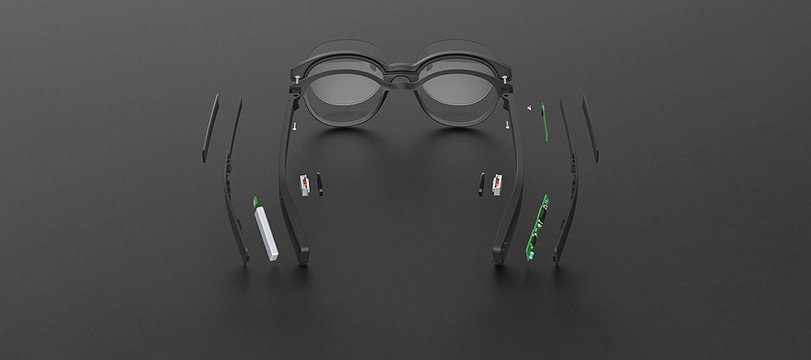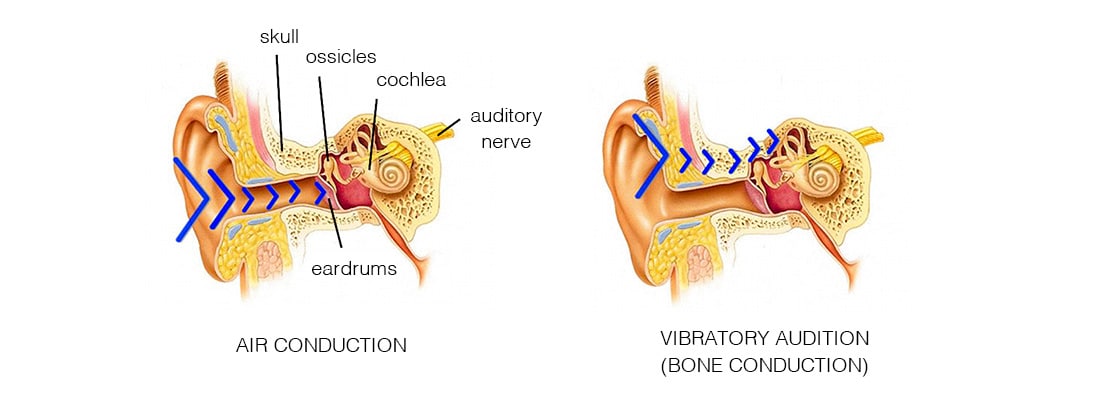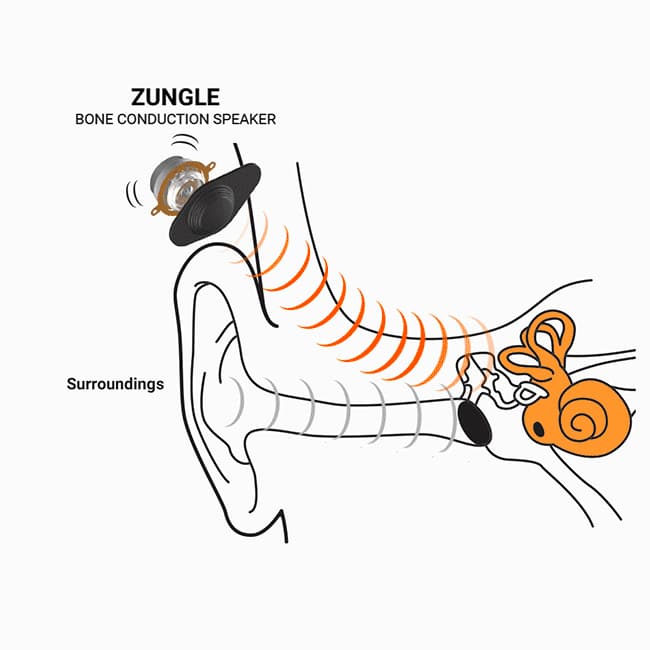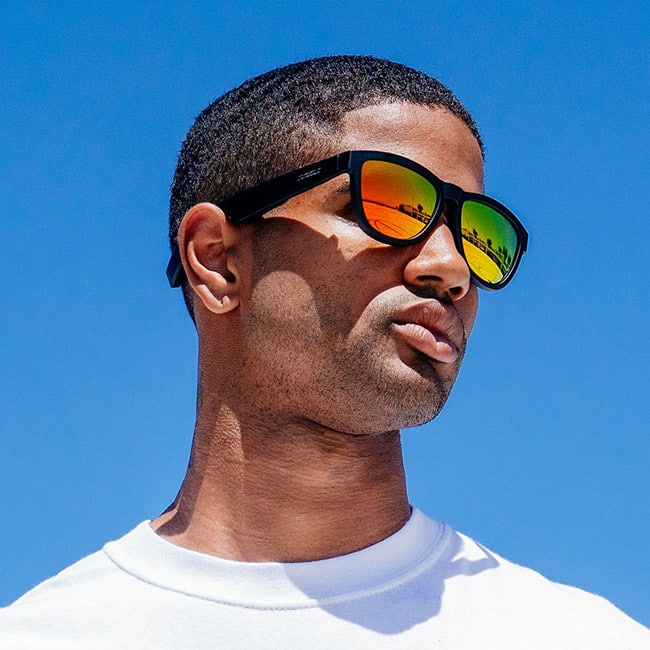
03:55 -
© VocalSkull
Can you imagine listening to your favourite music or making a hands-free phone call, whilst being able to listen to the sounds of your surroundings simultaneously? And without damaging your eardrums? A science-fiction-approved technology, this is exactly what bone conduction glasses are designed to do. All sound a bit confusing? Here we explain how it works, and the many advantages of bone conduction for users – and their eardrums.

© VocalSkull
Bone conduction (also referred to as osteophony) is based on a scientific principle that allows sound to be transmitted through vibrations along the inside of the ear. These vibrations are created by small electronic devices (known as transducers) which are placed on the temples, and transform electric signals into mechanical vibrations. The vibrations then pass through the cranium and send the sound directly to the inner ear, whose scientific name is the cochlea.
The latest models created using this technology have been adapted so as to render these vibrations almost imperceptible and so do not interfere with normal hearing. In this way, bone conduction is very different to our normal way of hearing which is largely based on conduction through soundwaves in the air, and specifically in which noise is transmitted through the ear canal and the eardrums.

© myhumankit.org
One of the first mentions of bone conduction is from 1923 in the science fiction writing of Hugo Gernsback in which he describes a hearing aid device called an osophone. Going back further in history still, one of the most significant early adopters of this technology was Beethoven. Developing partial deafness at the age of 27, the composer became totally deaf twenty years later. At the beginning of the 19th century when scientific experimentation was rife, Beethoven benefited from the new investigations into sound and audition in order to remedy his own devastating loss of hearing and find new ways to continue practising his music and composing. One of the ways he did this was to use wooden sticks that he clamped around his teeth and stuck to his piano. By biting the wooden stick between his teeth very firmly, he would pick up the vibrations of the music, so effectively allowing him to listen to himself play through his jaw!

© Optishokz
As it allows one to listen to music and audio or make a phone call, all whilst keeping the ear cavities open, the first and most obvious advantage of bone conduction is that it allows the user to be simultaneously exposed to the sounds of one’s environment, unlike conventional headphones. It is perhaps unsurprising then that among the first users of bone conduction technology was the military, as it allows for communication whilst also allowing its user to be acutely in tune with their immediate environment.
For the wider public, the emission of sound through the ear and skull bones is useful as it creates a safer way of listening to music when practising sports outside, particularly in noisy urban areas where there are potential hazards such as traffic. Bone conduction also has benefits if you are doing an activity that requires one to interact or respond to the people or stimuli of your surroundings simultaneously. From this perspective, bone conduction is particularly helpful for those who are blind or partially sighted, and so who are more reliant on their hearing.
Because it does not require the ear canals in order to transmit sounds, bone conduction is also used by people who are deaf or who suffer from hearing problems linked to the deterioration of these auditory passages. The use of bone conduction technology is used widely in hearing aids (prosthetics and headsets). For the large number of people who suffer from tinnitus, bone conduction can also be a huge asset as it helps to not aggravate further the seriousness of the current condition.

© Zungle
Winning a gold medal in the Lépine competition in 2016 for the creation of their bone conduction headsets, Aftershokz is a Chinese business who, having previously collaborated with Google on the first Google Glass model, have since been developing audio systems for sports glasses that will become available under the name of Optishokz Revvez. The principal is simple: transducers fit on the end part of the titanium frame and are wrapped around the ears. The glasses use Bluetooth (version 4.2) to connect to your smartphone so the wearer can listen to music, audio and make calls. These can be controlled via buttons fitted onto the right hand side of glasses, where you will also find the device’s charging point.
Fitted with a microphone on both sides, the sporty-style glasses also allow the wearer to make use of voice-assistive technology such as Siri and Google Assistant and the battery life lasts for up to 6 hours of continued usage. They are currently available in 5 colours: (polarized grey, transparent, shaded grey, yellow and orange), and the polycarbonate lenses are interchangeable. The certified IP55 model is lightweight (weighing only 48 grams) and is also water and dust resistant with UV400 protection, uses TR90 nylon for its frame and has a rubber fitting around the nose. The glasses are currently priced at $179.
Based in California, the company Zungle have also created sunglasses that use bone conduction, but, using a more fashionable style inspired by Ray-Ban’s classic Wayfarers, will perhaps appeal to a greater number of people. Their second model, called the Zungle V2 Viper, works using Bluetooth 5.0, has a IPX4 certification, meaning they are both sweat and water resistant, weigh 50 grams and can last for up to four hours of wireless battery life. Three colours are currently available for their plastic frames (white, black and grey) and the polarised, polycarbonate UV400 protection lenses come in eight different colours. The transducers are placed behind the temples and the command buttons are situated on the side of the frames.
Bone conduction glasses are also available from other brands, such as the Alien 5 model by the Chinese company VocalSkull. The price ranges from 85 to 199 euros, depending on the exact model.

© Zungle

© Zungle

© Zungle
Creating a new way of listening to music and making phone calls whilst in noisy environments, bone conduction offers innovative solutions to problems that henceforth weren’t believed possible on a mass scale. Also aiding people who suffer from auditory difficulties (particularly when they are linked to sound transmission, hearing deterioration and tinnitus) in a new, inventive way. Also having huge benefits for blind and short sighted people, this technology has a particular role to play when it comes to questions of accessibility and disability.
From a purely auditory perspective, whilst the current bone conduction headphones on the market offer a satisfactory sound quality, they do not yet match that of conventional high-quality headphones. However, with the progress that has been made in recent years in this area, the future is extremely promising, especially as so many big tech companies and new start-ups are now showing an interest in developing the technology for a wide audience.
In terms of improving auditory conditions or preventing hearing damage, however, bone conduction can’t work miracles, and whether it is bone or air conduction you are using, it is always advisable not to listen to music at too high a volume, and even these new headphones have the capacity to damage your ears just as classic headphones can.